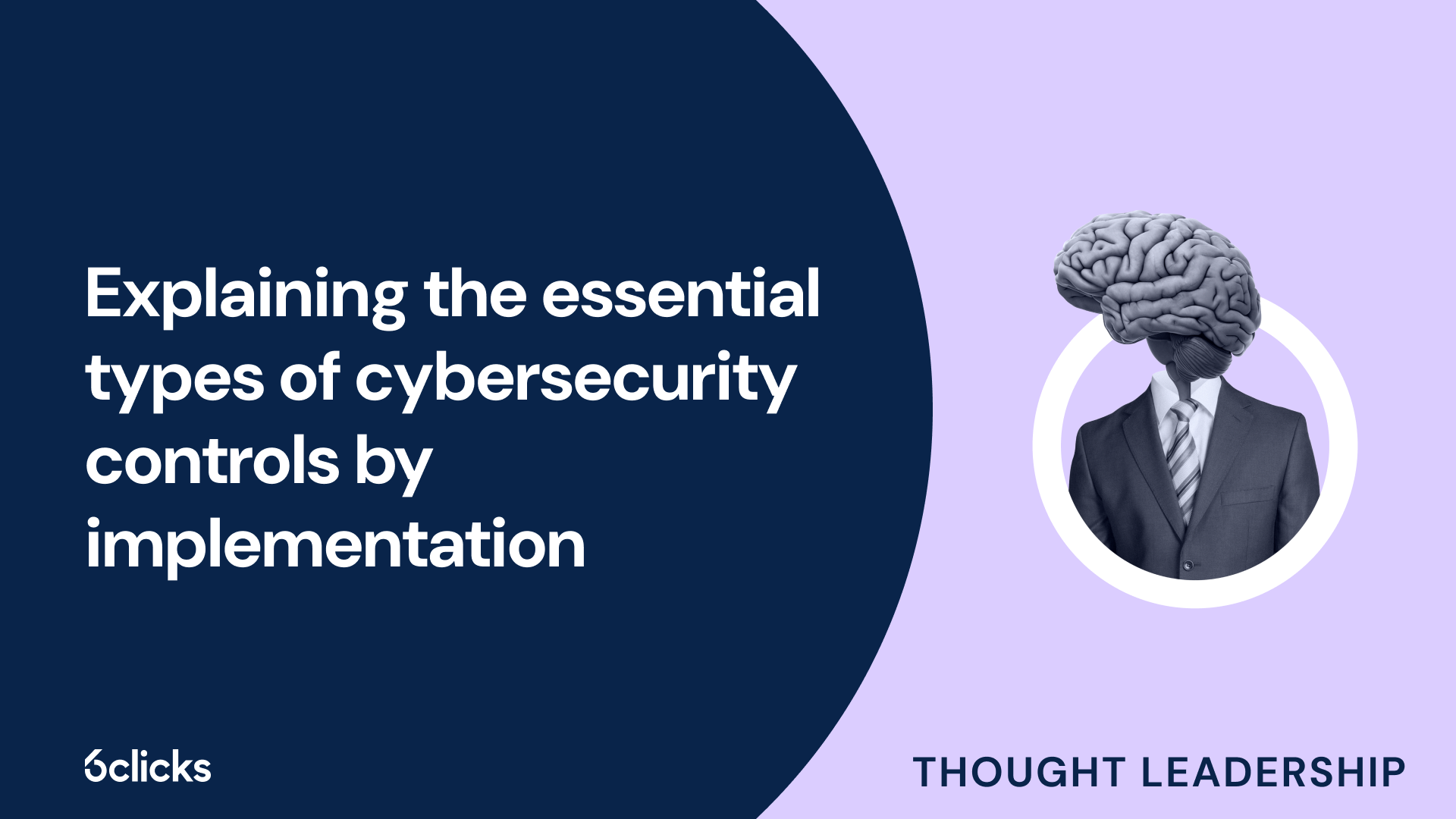
Controls form the backbone of any security program, helping organizations close vulnerabilities and strengthen resilience from the ground up. Yet today, many still struggle to build a cohesive approach. KPMG’s 2025 Risk and Resilience Survey of more than 200 U.S. C‑Suite leaders reveals that 52% of organizations do not have integrated risk and resilience capabilities. This gap underscores why understanding and implementing the right security measures is crucial. In this blog, we will explore the key types of cybersecurity controls and the role they play in mitigating risk and ensuring operational continuity. Learn more below.
What are the different types of controls?
Security controls are measures designed, implemented, and monitored to protect critical data, systems, and operations. They are commonly classified in two ways: one approach groups them by function, based on what the control is designed to achieve. The other approach groups them by implementation, based on how each control is applied within an organization’s security framework.
|
Types of controls by function |
Types of controls by implementation |
|
Preventive controls – Stop unwanted events from occurring (e.g., firewalls, access restrictions, or secure configurations) |
Technical controls – Technology-based measures that enforce security policies (e.g., encryption, network segmentation, or multi-factor authentication) |
|
Detective controls – Identify and alert when an event has occurred (e.g., intrusion detection systems, audit logs, or continuous monitoring) |
Physical controls – Measures that protect the physical environment and hardware (e.g., locked server rooms, CCTV, or biometric access systems) |
|
Corrective controls – Respond to and fix issues after an event (e.g., restoring from backups, updating controls, or carrying out incident response procedures) |
Administrative controls – Policies, processes, and training that guide how security is managed (e.g., user access policies, awareness training, or vendor risk management) |
For now, we will focus on the different types of controls by implementation in the context of cybersecurity, giving you a clearer picture of how they work in practice.
Types of cybersecurity controls by implementation
When it comes to cybersecurity, control implementation determines how each safeguard is applied across your environment, whether through technology, policies, or physical measures. Below, we break down each type and what it contributes to a stronger security posture.

Technical controls
Technical controls use technology to protect systems and data. They include mechanisms that enforce security policies, regulate access, and reduce the likelihood or impact of an incident. Many technical controls serve multiple functions at once—some prevent attacks, some detect suspicious activity, and others help restore systems after an event.
Examples include:
-
Firewalls that block unauthorized network traffic (preventive)
-
Intrusion detection and prevention systems that both identify suspicious patterns and stop attacks in progress (detective and preventive)
-
Antivirus and anti‑malware software that scans and removes threats (preventive and corrective)
-
Encryption that protects data even if it is stolen (preventive)
-
Automated backup and recovery solutions that restore data after an incident (corrective)
Because they directly control access, monitor activity, and in some cases repair damage, technical controls form a versatile first line of defense in any cybersecurity program.
Physical controls
On the other hand, physical controls safeguard the hardware, facilities, and supporting infrastructure that keep your digital environment secure. Without these, even the strongest technical measures can be bypassed if someone gains unauthorized physical access to servers, network devices, or storage media.
Examples include:
-
Locked server racks and data center cages that prevent unauthorized tampering with critical hardware
-
Biometric or smart‑card access systems controlling entry to rooms housing sensitive IT equipment
-
Surveillance cameras monitoring access points to network operations centers or server rooms
-
Secure storage for backup drives and removable media to prevent theft or unauthorized use
-
Tamper‑evident seals and hardware locks on networking gear to deter and detect physical compromise
These measures directly support cybersecurity by making it far harder for an attacker to bypass digital safeguards through physical intrusion or hardware manipulation.
Administrative controls
Administrative controls focus on the policies, procedures, and human factors that guide how security is managed and implemented. They set expectations, provide oversight, and ensure consistent practices across the organization. While many administrative controls are preventive, some serve a detective function by identifying non‑compliance or unusual activity, and others are corrective when they drive changes after an incident.
Examples include:
-
Security policies and user access management processes that define how resources are protected (preventive)
-
Mandatory security awareness training that reduces the likelihood of human error (preventive)
-
Regular audits and compliance reviews that uncover gaps or violations (detective)
-
Incident response playbooks and disaster recovery plans that guide remediation and restoration efforts after a breach or disruption (corrective)
-
Vendor risk assessments and ongoing oversight that both prevent issues and detect emerging risks (preventive and detective)
By shaping behavior, monitoring adherence, and driving improvements, administrative controls are a crucial layer in building and maintaining cybersecurity resilience.
Strategies to ensure effective control implementation
Implementing controls is only the first step; making sure they remain effective over time requires ongoing effort and strategy. Below are key practices that help organizations maintain optimal performance for their cybersecurity controls:
Aligning with cybersecurity standards and regulations
Following established frameworks helps ensure your controls meet baseline expectations and regulatory obligations. Depending on your industry and region, some of the most widely adopted cybersecurity frameworks include:
-
ISO 27001 – An internationally-recognized standard for building information security management systems (ISMS). It provides a structured approach to managing sensitive data through risk assessments, policies, and controls that align with global best practices.
-
DORA (Digital Operational Resilience Act) – An EU regulation that sets requirements for financial entities to ensure they can withstand and recover from ICT‑related disruptions. It emphasizes business continuity, risk management, and incident reporting.
-
NIST Cybersecurity Framework (CSF) – A U.S. framework for enhancing cyber resilience built around six core functions: Govern, Identify, Protect, Detect, Respond, and Recover. It is widely used across industries to guide risk management and control implementation.
-
CIS Controls – A U.S. framework made up of a prioritized set of actions developed by the Center for Internet Security. It offers organizations a practical roadmap for hardening systems, reducing common attack surfaces, and strengthening their overall cybersecurity posture.
-
TISAX (Trusted Information Security Assessment Exchange) – A European standard tailored for the automotive industry and its supply chains. It provides a framework for assessing and exchanging information security levels, ensuring that partners meet agreed security requirements.

6clicks can help you instantly align your controls with various frameworks using Hailey AI. Automatically map your controls to specific framework requirements and identify compliance gaps within seconds.
Continuous monitoring and remediation
Using tools that track control performance in real time helps you detect gaps early and address them before they escalate. With 6clicks, you can automate this process and maintain real-time control effectiveness through Continuous Control Monitoring. Get instant alerts of anomalies, control failures, or configuration issues. Then, with integrated issue management, ensure that all findings are logged, investigated, and resolved efficiently—creating a continuous cycle from oversight and detection to remediation.
Conducting regular internal and external audits
Regular audits validate that your controls are operating as intended and highlight areas for refinement. While external audits offer an independent assessment that supports the maintenance of certifications and compliance with industry standards, internal audits help you uncover gaps, inefficiencies, or non‑compliance early and provide an opportunity to strengthen controls and processes before any external review. Together, they create a feedback loop that reinforces accountability and ongoing improvement.
Building a culture of cybersecurity readiness
Effective security goes beyond policies and tools—it relies on people. Fostering a culture of cybersecurity readiness means ensuring that everyone, from executives to end users, understands their role in protecting systems and data. This includes regular security awareness training, clear communication of policies, simulated phishing exercises, and reinforcing secure behavior through everyday workflows.
By embedding security into your organization's mindset and routines, you create an environment where controls are not just implemented but actively supported and sustained.
Get started with 6clicks
Build a stronger security foundation with 6clicks. Our platform makes it simple to map, monitor, and manage all your controls through AI-powered automation, centralized registers, and continuous monitoring.
-
Implement controls, assign responsibilities, and link to compliance requirements, risks, assets, and other relevant data
-
Leverage AI-powered compliance mapping to align multiple frameworks and identify control gaps
-
Automate control testing and evidence collection and ensure optimal control performance in real time
-
Built-in audit and assessment functionality to evaluate control design and implementation
Take the next step toward a smarter, more efficient cybersecurity program today.


